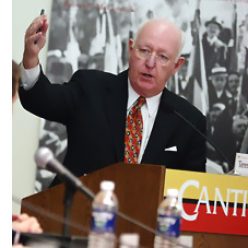It should not have come as a surprise to Israel.
Not after Egyptian President Anwar el Sadat threatened war repeatedly, not after Egypt and Syria assembled massive military forces on the frontiers, not after Jordan’s King Hussein flew secretly to Israel to warn Prime Minister Golda Meir that an attack was imminent.
But it did.
And when full-scale war erupted at 2 p.m. on October 6, 1973, Israel was rocked back on its heels. In the first three days, Egypt re-crossed the Suez Canal and retook portions of the western Sinai; Syria rolled across the Golan Heights and shelled Israel’s northern settlements.
Israel hurriedly mobilized, fought back, regained lost territory, pushed forward to occupy more Arab land and finally, reluctantly, accepted a ceasefire on October 25.
When the shooting stopped, Israel’s forces stood in place, 25 miles from Damascus, 63 miles from Cairo.
The war came as a surprise because of skillful deception on the Arab side, but mainly because of hubris on the Israeli side.
Israel had grown complacent since its total victory in the Six Day War in 1967, convinced that Egypt would not dare attack without more and greater Soviet help and that Syria would never attack without Egypt.
Unmistakable warning signs were ignored or discounted. As late as the morning of October 6th, Defense Minister Moshe Dayan remained skeptical that Sadat would launch an all-out assault. Only when a well-placed spy, Ashraf Marwan, the late President Nasser’s son-in-law, told the head of Israeli intelligence that Yom Kippur was the day, was the full mobilization order given. It was just six hours before the battle began.
So, the first and most important lesson of the war is obvious: never dismiss your enemy, never assume that something that was once true will always be true.
The legacy of the 1973 war, which the Arabs call the Ramadan War, is more complex and poignantly relevant 40 years later. Negotiations after the war returned the Sinai to Egypt and led to the Camp David accords and a peace treaty that is frosty, but still in place. The armistice along the Golan Heights is largely intact, despite the .current chaos in Syria. Israel signed a peace treaty with Jordan, which sent only a token force to the front in 1973.
But peace with the Palestinians is as elusive as ever 40 years later. Trust is as elusive as ever, on both sides.
More than anything, the war hardened attitudes on all sides.
Israelis have grown progressively more skeptical, if not cynical, about ever achieving a lasting peace with their neighbors. Israeli settlers have become more determined to dig in. The Israeli right challenges the notion of a two-state solution. The Israeli left struggles to hear its own voice. Two generations of Israelis have grown up with the 1973 war as an object lesson that no one but themselves can be trusted with their security.
On the Arab side, the Ramadan War restored a sense of pride. Despite ultimate setbacks on the battlefield, Sadat achieved his principal goal: breaking the deadlock with Israel and forcing negotiations for the return of the Sinai. Syria’s Hafez al Assad emerged from the war battered, but still in power.
Nonetheless, the war convinced many Egyptians of the futility of defeating Israel on the battlefield. The Egyptian officer corps has grown wealthy and powerful since, but they haven’t fought Israel in 40 years and they are not likely to in the next 40. Their problems are at home, in the Sinai and Tahrir Square.
If the Arabs have largely, if reluctantly, accepted that Israel is here to stay, it was the ultimate outcome of the 1973 war that made that case.
The Palestinians emerged from the war as the recognized authority of any future independent, sovereign Palestinian state. That status was formally enshrined in the 1974 Rabat summit conference that followed the October War, even if a genuine Palestinian state is only marginally closer to reality 40 years later.
There were major international repercussions as well: the newly-established détente between the Soviet Union and United States survived its first major challenge, Europe felt the sting of the first organized Arab oil embargo and the United States emerged as the indispensible negotiator of any future peace agreements in the Middle East.
The 1973 war was a watershed event, and not just for the region.
Forty years is not a long time in the larger history of the Middle East. But it is long enough to pause, look back, and recognize that the October War changed some things, even many things, but not everything.
TERENCE SMITH covered the 1973 October War as the Israel Correspondent for The New York Times.
